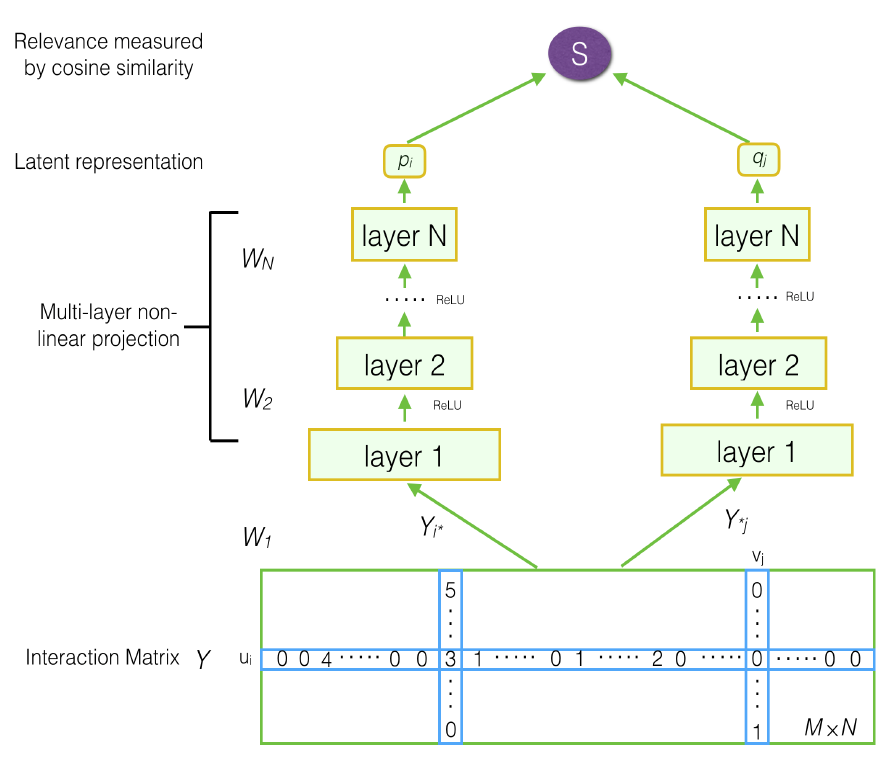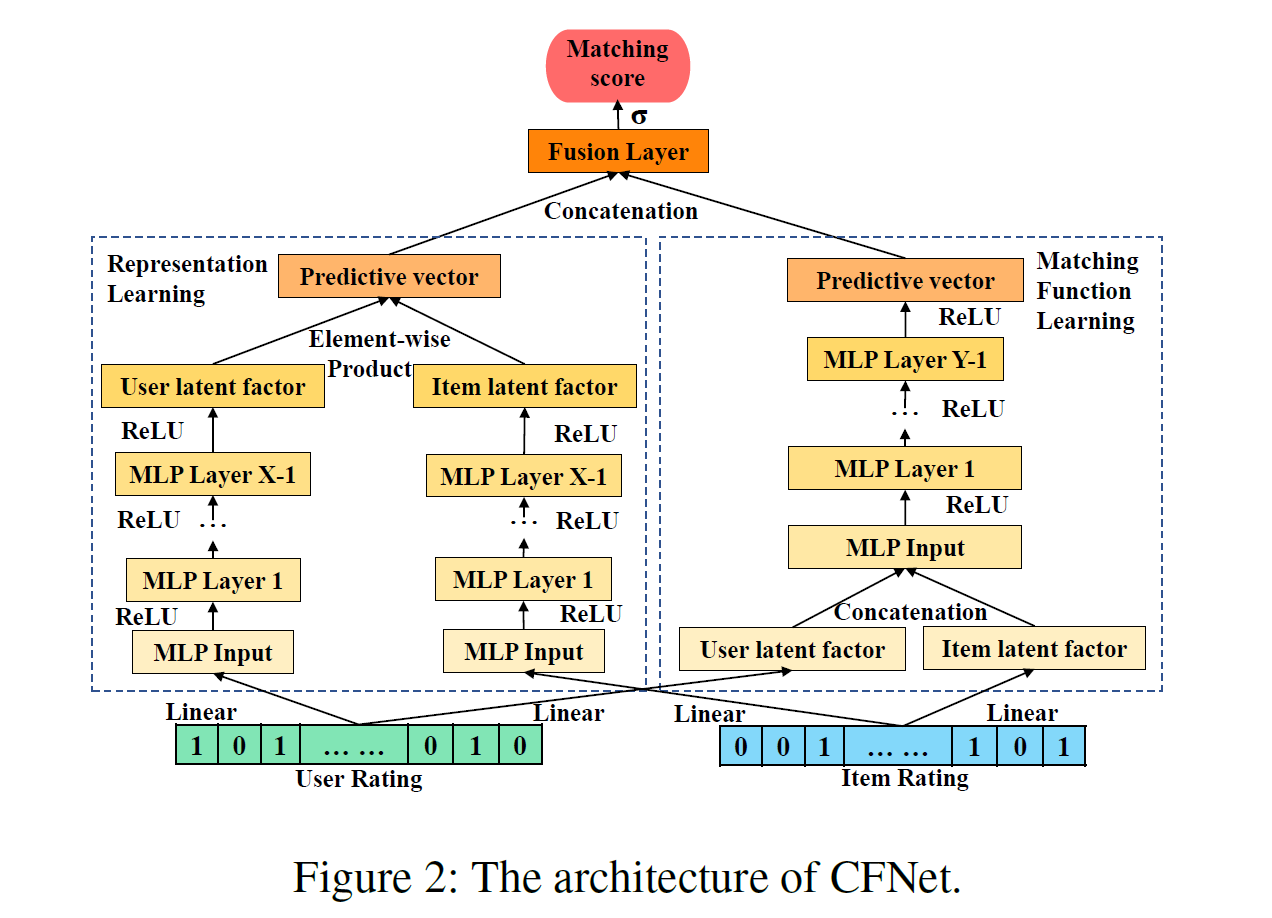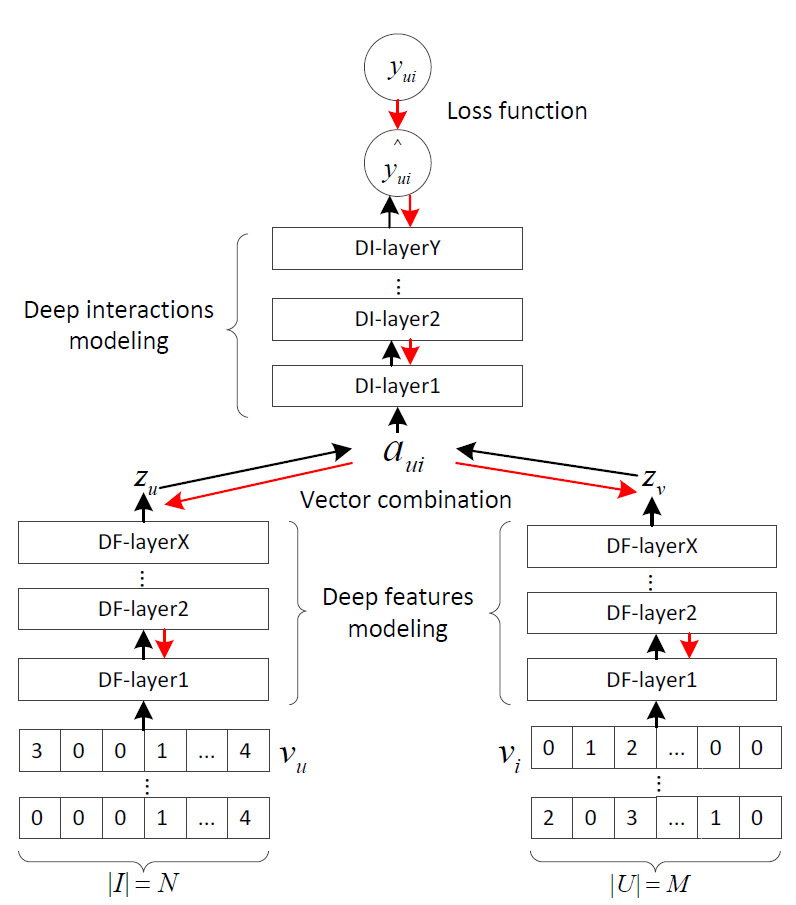History Embedding based Latent Factor Model
Based on the following lectures
(1) “Recommendation System Design (2024-1)” by Prof. Ha Myung Park, Dept. of Artificial Intelligence. College of SW, Kookmin Univ.
(2) "Recommender System (2024-2)" by Prof. Hyun Sil Moon, Dept. of Data Science, The Grad. School, Kookmin Univ.
Learning Objectives
- 표현 학습(Representation Learning)
- 사용자와 아이템을 공동의 잠재요인 공간에 표현하는 방법
- 매칭 강도 추정 시 내적(Inner Product) 등 선형 유사도 함수를 적용함
- 저차원(Low-rank) 유사도 구조를 효율적으로 포착할 수 있음
- 매칭 함수 학습(Matching Function Learning)
- 사용자-아이템 쌍을 입력으로 하여 매칭 함수를 직접 학습하는 방법
- 복잡하고 비선형적인 매칭 함수를 근사할 수 있음
DMF
- 문제 의식: 아이디 임베딩(ID Embedding) 입력 표현의 한계점
- 아이디 임베딩 방식은 초기 표현(식별자)의 정보량이 부족하여 학습이 느리거나 성능이 제한됨
DMF(DeepMatrixFactorization): 사용자-아이템 상호작용 행렬과 그 전치 행렬을 초기 표현으로 사용하여 저차원 표현 학습을 수행하는 모형- Xue, H. J., Dai, X., Zhang, J., Huang, S., & Chen, J.
(2017, August).
Deep matrix factorization models for recommender systems.
In IJCAI (Vol. 17, pp. 3203-3209).
- Xue, H. J., Dai, X., Zhang, J., Huang, S., & Chen, J.
Notation
- $u=1,2,\cdots,M$: user idx
- $i=1,2,\cdots,N$: item idx
- $\mathbf{Y} \in \mathbb{R}^{M \times N}$: user-item interaction matrix
- $\overrightarrow{\mathbf{u}}_{u} \in \mathbb{R}^{K}$: user latent factor vector
- $\overrightarrow{\mathbf{v}}_{i} \in \mathbb{R}^{K}$: item latent factor vector
- $\hat{y}_{u,i}$: interaction probability of user $u$ and item $i$
How to Modeling
-
user latent factor vector representation learning:
\[\begin{aligned} \overrightarrow{\mathbf{u}}_{u} &= \text{MLP}_{\text{ReLU}}(\mathbf{Y}_{u*}) \end{aligned}\] -
item latent factor vector representation learning:
\[\begin{aligned} \overrightarrow{\mathbf{v}}_{i} &= \text{MLP}_{\text{ReLU}}(\mathbf{Y}_{*i}) \end{aligned}\] -
Predict interaction probability of user $u$ and item $i$:
\[\begin{aligned} \hat{y}_{u,i} &= \cos(\overrightarrow{\mathbf{u}}_{u}, \overrightarrow{\mathbf{v}}_{i})\\ &= \frac{\overrightarrow{\mathbf{u}}_{u} \cdot \overrightarrow{\mathbf{v}}_{i}}{\Vert \overrightarrow{\mathbf{u}}_{u} \Vert \cdot \Vert \overrightarrow{\mathbf{v}}_{i} \Vert} \end{aligned}\]
DeepCF
- 문제 의식: 표현 학습 방식과 매칭 함수 학습 방식의 상호 보완적 관계
- 표현 학습은 저차원 유사도 구조를 포착하여 사용자, 아이템의 일반화된 표현을 도출하는 데 강점
- 매칭 함수 학습은 사용자와 아이템 간 복잡하고 비선형적인 상호작용 과정을 근사하는 데 강점
DeepCF: 표현 학습 모듈과 매칭 함수 학습 모듈을 병렬 학습하는 앙상블 모형- Deng, Z. H., Huang, L., Wang, C. D., Lai, J. H., & Yu, P. S.
(2019, July).
Deepcf: A unified framework of representation learning and matching function learning in recommender system.
In Proceedings of the AAAI conference on artificial intelligence (Vol. 33, No. 01, pp. 61-68).
- Deng, Z. H., Huang, L., Wang, C. D., Lai, J. H., & Yu, P. S.
- Components
CFNet-rl:RepresentationLearningCFNet-ml:Matching FunctionLearningCFNet:CFNet-rl&CFNet-mlEnsemble
Notation
- $u=1,2,\cdots,M$: user idx
- $i=1,2,\cdots,N$: item idx
- $\mathbf{Y} \in \mathbb{R}^{M \times N}$: user-item interaction matrix
- $\overrightarrow{\mathbf{u}}_{u} \in \mathbb{R}^{K}$: user latent factor vector
- $\overrightarrow{\mathbf{v}}_{i} \in \mathbb{R}^{K}$: item latent factor vector
- $\overrightarrow{\mathbf{z}}_{u,i}$: predictive vector of user $u$ and item $i$
- $\hat{y}_{u,i}$: interaction probability of user $u$ and item $i$
How to Modeling
-
\[\begin{aligned} \hat{y}_{u,i} &= \sigma(\overrightarrow{\mathbf{w}} \cdot [\overrightarrow{\mathbf{z}}_{u,i}^{\text{(RL)}} \oplus \overrightarrow{\mathbf{z}}_{u,i}^{\text{(ML)}}]) \end{aligned}\]CFNetisCFNet-rl&CFNet-mlEnsemble
CFNet-rl
-
user latent factor vector representation learning:
\[\begin{aligned} \overrightarrow{\mathbf{u}}_{u} &= \text{MLP}_{\text{ReLU}}(\mathbf{Y}_{u*}) \end{aligned}\] -
item latent factor vector representation learning:
\[\begin{aligned} \overrightarrow{\mathbf{v}}_{i} &= \text{MLP}_{\text{ReLU}}(\mathbf{Y}_{*i}) \end{aligned}\] -
predictive vector of user $u$ and item $i$:
\[\begin{aligned} \overrightarrow{\mathbf{z}}_{u,i} &= \overrightarrow{\mathbf{u}}_{u} \odot \overrightarrow{\mathbf{v}}_{i} \end{aligned}\] -
if use
\[\begin{aligned} \hat{y}_{u,i} &= \sigma(\overrightarrow{\mathbf{w}} \cdot \overrightarrow{\mathbf{z}}_{u,i}) \end{aligned}\]CFNet-rlas a single prediction module:
CFNet-ml
-
generate user latent factor vector through linear transformation:
\[\begin{aligned} \overrightarrow{\mathbf{u}}_{u} &= \mathbf{W} \cdot \mathbf{Y}_{u*} \end{aligned}\] -
generate user latent factor vector through linear transformation:
\[\begin{aligned} \overrightarrow{\mathbf{v}}_{i} &= \mathbf{W} \cdot \mathbf{Y}_{*i} \end{aligned}\] -
predictive vector of user $u$ and item $i$:
\[\begin{aligned} \overrightarrow{\mathbf{z}}_{u,i} &= \text{MLP}_{\text{ReLU}}(\overrightarrow{\mathbf{u}}_{u} \oplus \overrightarrow{\mathbf{v}}_{i}) \end{aligned}\] -
if use
\[\begin{aligned} \hat{y}_{u,i} &= \sigma(\overrightarrow{\mathbf{w}} \cdot \overrightarrow{\mathbf{z}}_{u,i}) \end{aligned}\]CFNet-mlas a single prediction module:
J-NCF
- 문제 의식
- 아이디 임베딩(ID Embedding): 사용자와 아이템 표현을 무작위로 초기화한 후 매칭 함수 학습을 수행하므로 표현 학습이 미흡함 (ex.
NCF) - 히스토리 임베딩(History Embedding): 사용자-아이템 상호작용 행렬과 그 전치 행렬을 활용하여 표현 학습을 수행하나 매칭 함수는 선형 유사도 함수에 의존함 (ex.
DMF) - 앙상블(Ensemble): 표현 학습과 매칭 함수 학습을 분리하여 수행하므로 각 모듈이 서로의 학습을 보완하거나 강화하지 못함 (ex.
CFNet)
- 아이디 임베딩(ID Embedding): 사용자와 아이템 표현을 무작위로 초기화한 후 매칭 함수 학습을 수행하므로 표현 학습이 미흡함 (ex.
J-NCF(JointNeuralCollaborativeFiltering): 표현 학습과 매칭 함수 학습을 통합 훈련(Joint Training)하는 모형- Chen, W., Cai, F., Chen, H., & Rijke, M. D.
(2019).
Joint neural collaborative filtering for recommender systems.
ACM Transactions on Information Systems (TOIS), 37(4), 1-30.
- Chen, W., Cai, F., Chen, H., & Rijke, M. D.
Notation
- $u=1,2,\cdots,M$: user idx
- $i=1,2,\cdots,N$: item idx
- $\mathbf{Y} \in \mathbb{R}^{M \times N}$: user-item interaction matrix
- $\overrightarrow{\mathbf{u}}_{u} \in \mathbb{R}^{K}$: user latent factor vector
- $\overrightarrow{\mathbf{v}}_{i} \in \mathbb{R}^{K}$: item latent factor vector
- $\overrightarrow{\mathbf{z}}_{u,i}$: predictive vector of user $u$ and item $i$
- $\hat{y}_{u,i}$: interaction probability of user $u$ and item $i$
How to Modeling
-
user latent factor vector representation learning:
\[\begin{aligned} \overrightarrow{\mathbf{u}}_{u} &= \text{MLP}_{\text{ReLU}}(\mathbf{Y}_{u*}) \end{aligned}\] -
item latent factor vector representation learning:
\[\begin{aligned} \overrightarrow{\mathbf{v}}_{i} &= \text{MLP}_{\text{ReLU}}(\mathbf{Y}_{*i}) \end{aligned}\] -
matching function learning:
\[\begin{aligned} \overrightarrow{\mathbf{z}}_{u,i} &= \text{MLP}_{\text{ReLU}}(\overrightarrow{\mathbf{u}}_{u} \oplus \overrightarrow{\mathbf{v}}_{i}) \end{aligned}\] -
Predict interaction probability of user $u$ and item $i$:
\[\begin{aligned} \hat{y}_{u,i} &= \sigma(\overrightarrow{\mathbf{w}} \cdot \overrightarrow{\mathbf{z}}_{u,i}) \end{aligned}\]



